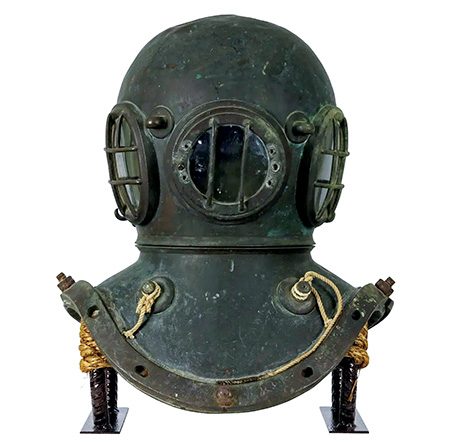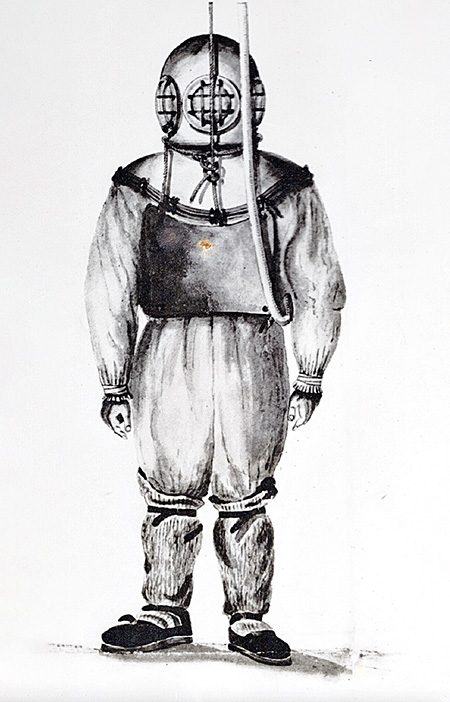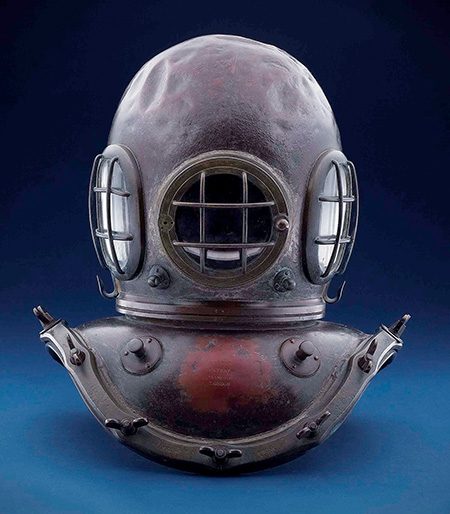Traditional copper and brass deep-sea dive helmets often attract the modern dive community’s attention. International interest recently spiked when a helmet believed to be from the dawn of American professional diving sold for a record-setting $54,000 in Wichita, Kansas.
The origins of antique and vintage dive helmets like that one were long shrouded in mystery. The Historical Diving Society (HDS) provides an international network of dive historians who continue to provide new research and insight into the helmets and their history.
Most dive historians confirm that what we recognize as the deep-sea dive helmet that launched professional diving as a trade was built in England in 1840 by Augustus Siebe, who incorporated contributions from others to perfect the design.
Siebe’s helmet had two parts: the bonnet (the top part) and the breastplate (the bottom part). The bonnet covered the diver’s head and connected with a segmented screw neck ring to the breastplate, which covered the diver’s shoulders and chest. The breastplate featured 12 bolts and nuts at its outer edges that clamped four individual brass straps, called brales, over the collar of the diver’s suit to make a waterproof seal. Air was pumped into the helmet through a hose attached to the back of the bonnet. Only the diver’s hands were exposed to the water.
The viewport glass was convex, and a valve located below the air intake elbow at the back of the bonnet released the diver’s expired air. The features gradually improved as Siebe and others modified his designs over the decades.
The $54,000 Helmet
The record-setting auction helmet had no manufacturer’s plaque or name stamping but showed the distinct features of manufacturing in the 1850s and 1860s, such as the convex glass, nonadjustable exhaust valve, and the bonnet’s hand-formed copper panels. The bonnet’s height and the breastplate’s width are additional indicators.
The bonnet had a few dents but retained the internal ducting that guided the incoming air from the back of the bonnet over the three viewports. While we can be reasonably sure of the date, the lack of manufacturer’s markings makes it difficult to determine who made this helmet.

Helmet Collecting
Collecting these helmets has never been easy, given the limited number manufactured. Made of nonferrous metal, they have the potential to last for centuries. An early diver may have had only one helmet for their entire career, as they could keep it functional with minimal maintenance. That durability, plus the small community of professional divers, resulted in small demand and production numbers.
The most abundant American historical dive helmet is the U.S. Navy Mark V, because it was made in numbers far surpassing any other designs. As World War I raged in Europe, a U.S. Navy team led by gunner George Stillson designed the Mark V for military use. The helmet was in service from 1916 to 1984, when it was finally phased out for fiberglass helmets.
The traditional deep-sea dive helmet drew the public’s attention to human exploration in the underwater world. After those copper and brass dive helmets had become technically obsolete, they were gradually retired from service and replaced with modern lightweight helmets. These abandoned artifacts often sat forgotten in dive lockers until about 50 years ago, when a small international collector’s market started to develop as maritime antique dealers and auction houses found the retired helmets. Many helmets had initially entered the market from military surplus sales, collected by people inside and outside commercial diving who were fascinated with the helmets’ history and appearance.

In the early days there were no groups for dive helmet collectors; instead they were just a minor corner of the established maritime antique market. There was minimal information available about the helmets and no recognized support organization with any knowledgeable authority. The industry that originally used the helmets was small, and access to it was difficult for outsiders. Manufacturers’ catalogs and military dive manuals were the only printed research material on the helmets, but help soon arrived.
The first book to provide details about the helmets to assist historians or collectors was Robert Martin’s The Deep Sea Diver: Yesterday, Today, and Tomorrow. Published in 1978 by the highly respected Cornell Maritime Press in Cambridge, Maryland, the book featured a photo of an Augustus Siebe helmet. The book announced the arrival of dive equipment as a valid maritime collectible and secured Martin a place in dive history.
In 1981 Bill Momsen started publishing Nautical Brass magazine in California. It featured articles on dive helmets, and sometimes helmets were for sale in the magazine’s classified advertisement section. In 1988 collector Leon Lyons self-published Helmets of the Deep, a full-color, 370-page pictorial guide to the world’s dive helmets. The book remains the leading reference for historians and helmet collectors.

The growth of the internet and international HDS groups in the 1990s helped provide a more organized structure for historians and collectors groups. Regional HDS organizations became the leaders for groups of divers who restored and dived with vintage dive helmets, helping to keep alive the traditional practices of helmet diving and in the public eye.
The membership magazines of these international HDS groups regularly publish articles on dive helmets, and the HDS USA’s full-color Journal of Diving History publishes a quarterly auction report that tracks the prices of helmets and other dive collectibles.
The $54,000 helmet is the latest milestone on dive history’s road to a future in which more discoveries will be made and more history will be revealed. AD
© Alert Diver — Q2 2024